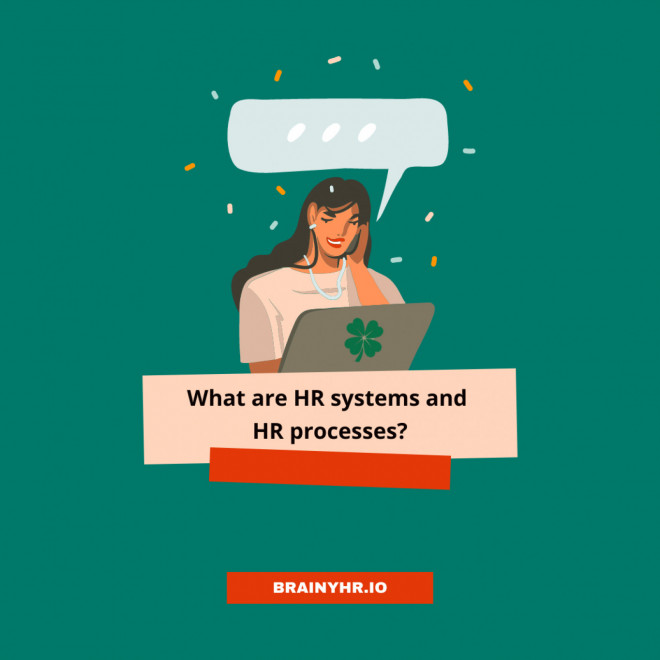TABLE OF CONTENTS
What are HR systems?
HR Systems streamline human resources management, improve HR-decision making, enable legislative compliance and help HR teams better support managers and employees. Also known as HR Management Systems (HRMS) or HR Information Systems (HRIS), an HR system is a business application designed to manage the complete employee lifecycle from recruitment and onboarding through core HR administration to employee engagement and performance management.
Why should the company take care of the right development of HR processes?
HR processes in a company are very important for any company. Depending on how well the foundation of HR processes will be built will depend on the overall efficiency and effectiveness of any business. By means of a system approach to building an HR department, you can strengthen the brand of the company.
HR managers should regularly check whether the HR process objectives coincide with the company's global goals. Regular inspection allows HR leaders to make sure the chosen strategy is correct.
In the modern world, almost all companies use technologies.
Of course, if these companies have plans, be competitive, go to the future, and serve their clients with high-tech solutions.
Therefore, automation of HR processes is practically a trend now. More and more new offers and variants of HR software appear on the market, and more and more enterprises start to use some of the variants.
Technological automation facilitates the crucial connection between the working force, during such processes as onboarding, offboarding, and communication of co-workers. If you also think about this solution for your company, we suggest you consider our Brainy HR software. Register now for a 1-month free demo.
Automated and structured management methods can improve the productivity of HR processes. Consistent application of a single system can help HR track progress, identify areas for improvement and re-design their practices in an organized manner. While the system provides structure and leadership, HR has to deal with people, so it must maintain basic human qualities in the process, such as flexibility, critical thinking, and perspective.
Also very important for building correct HR processes is that you should listen to your employees. The co-workers can provide you with the necessary information on how HR leaders can better manage the aspects of building HR processes.
After conducting a survey of employees or reviewing the results with different feedback, HR professionals can assess what their company can do to improve processes inside.
TOP 10 processes in Human Resources Management
1. Recruitment and selection
Recruitment is the process of attracting qualified candidates for an interview with your company for potential employment. For this HR - specialists use all necessary tools to attract and choose talents. It is important that these steps are followed by the recruitment process software, which can standardize a process that collects a lot of information, and may potentially be lost. HR - specialists should review each tool and determine its effectiveness in order to achieve the desired results.
2. Performance management
After HR specialists have selected the right employees and they are already working in the company, the management of efficiency becomes important. Management of efficiency - this is the second important process in the life of the company after the selection of personnel.
Usually, employees have a defined set of responsibilities, which they should care for. Performance management is a structure that allows employees to receive feedback on their performance and achieve the best results.
Companies typically work with an annual performance management cycle that involves planning, monitoring, reviewing, and rewarding employee performance. It is also one of the functions of the HR specialist's software. As a rule, all software on the market has the function of performance management.
3. HR Analytics
Analytics is an extremely important HR process. This process helps you to do things and analyze them, track results, and change methods for more effective work. Analytics is the engine of your company's development. The simple way to track critical data is through HR metrics or HR KPIs. These are specific measurements that give an answer to how the company works at this time. This report focuses on the current and past state of the organization. Using HR analysis, HR can also make predictions. By actively measuring and looking at these data, HR can make more decisions, driven by data. These solutions are often more objective, making it easier to find managerial support for these solutions.
4. Retention
According to recent studies, the shift to distance work has made it difficult to keep quality workers. In one survey, 58% of respondents said they would look for a new job if they did not allow to continue working remotely. According to such research, HR specialists should create conditions and new strategies to preserve current talent and further successful recruiting. These processes will continue to develop in such a context to win the war for talent in the future.
5. Onboarding
Onboarding is the process of integrating new employees into the company. During the selection, employees are entered into a large number of resources that they need for professional implementation, for example, description of roles, expectations of performance, and necessary training. The onboarding software can be designed to standardize the stages of onboarding and ensure that everyone knows their responsibilities and plans for their professional development. The onboarding process is necessary in order to expand the opportunities for employees who can positively influence business development with their results.
6. Offboarding
Offboarding is sometimes overshadowed by the onboarding process, but the departure process for employees can make a big difference in:
1) minimizing disruption
2) maintaining a positive employee experience and 3) protecting the company’s reputation as a desirable employer.
7. Training and development
Staff training has undergone many changes since the outbreak of the COVID-19 pandemic. Further changes take place even more scale.
All processes move toward globalization.
So now it will be necessary to study mostly online.
And the pandemic has changed our work, where we work, and in some cases with whom we work. This most likely means watching or additional training for many commands. According to one report, business leaders expect to invest in a number of initiatives in the coming months, including diversity, capital, and inclusion (65%), building relationships (55%), and professional development and training (39%).
8. Employee relations
Employees' relations consist of all personnel actions aimed at attracting employees and retaining employees. Attracting employees is simply to say, to the extent that the employees invested are in the company. Keeping employees provides for the creation of measures to ensure the satisfaction of employees at their workplaces
Healthy employee relationships are critical to reducing employee turnover. Ideally, HR teams use quantitative and qualitative means to measure employee engagement and its impact on retention. These methods are different forms of creating a two-way relationship between employees and their employers to ensure their work, which is one of the main aspects of employee-to-employee relationships.
9. Employee requests
Improving results for all types of employee requests can be as simple as using a workflow management system, allowing teams to create and automate unique workflows for each type of employee request. Sometimes referred to as HR software, these tools make it easier for teams to collaborate, giving everyone access—in any department—to provide input or approval to resolve the request.
10. Benefits and Compensation
Compensation and benefits are other keys to human resources management. Fair compensation is key to the motivation and preservation of employees.
A profitable offer of payment is a key part of attracting the best talent. This should be balanced with the company’s budget and profits. HR should monitor the increase in payment and establish payment standards.
This function is also available in the HR software.
Summary
HR processes in the company are extremely important for its full functioning. The further results and success of this business depend on how these processes are built in the company. In the modern world of globalization, technology and automated processes play a major role. HR processes also need to be automated. Use specialized software to automate human resources management processes.
If you plan to select and use one of them, we recommend that you consider our option. Brainy HR will help you effectively organize all HR processes in your company.


 Posted by Lillia
Posted by Lillia


